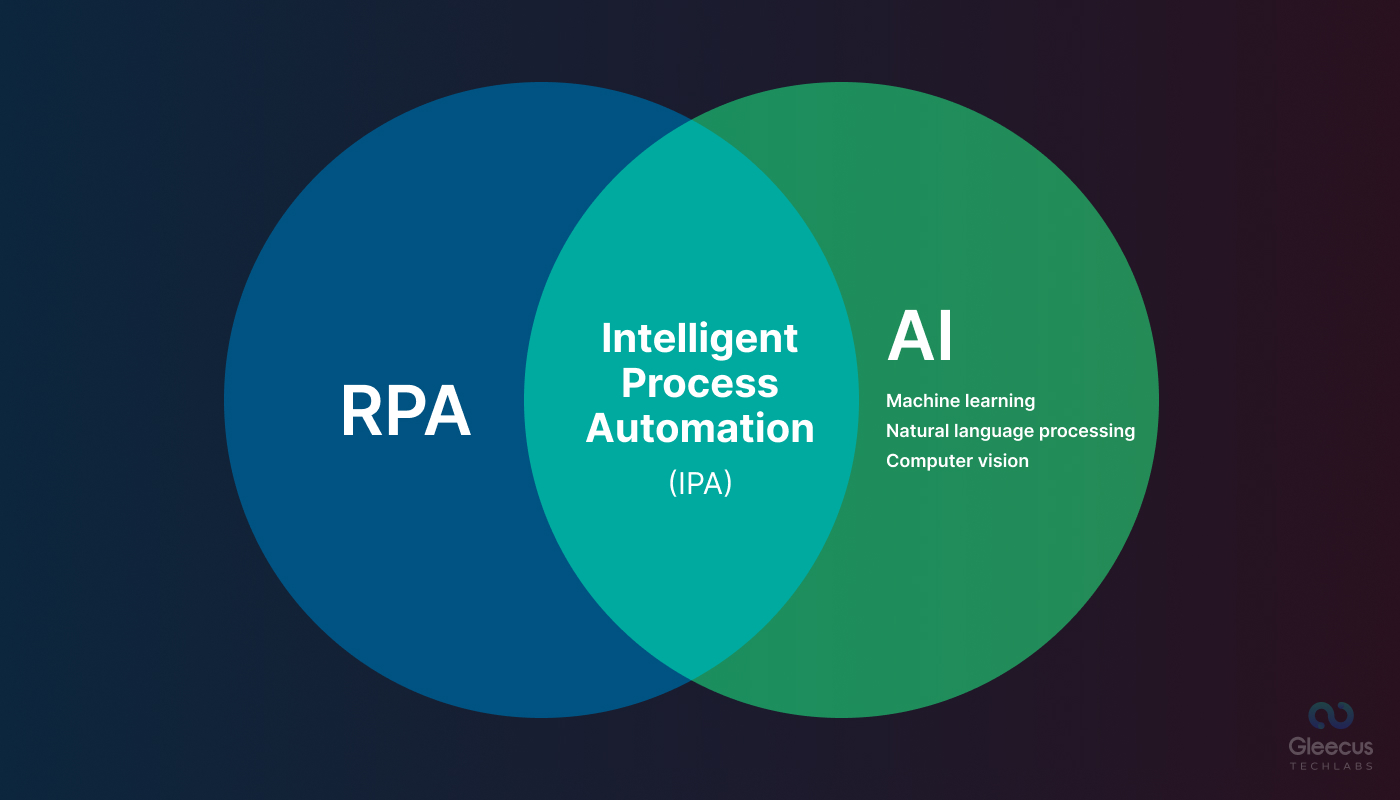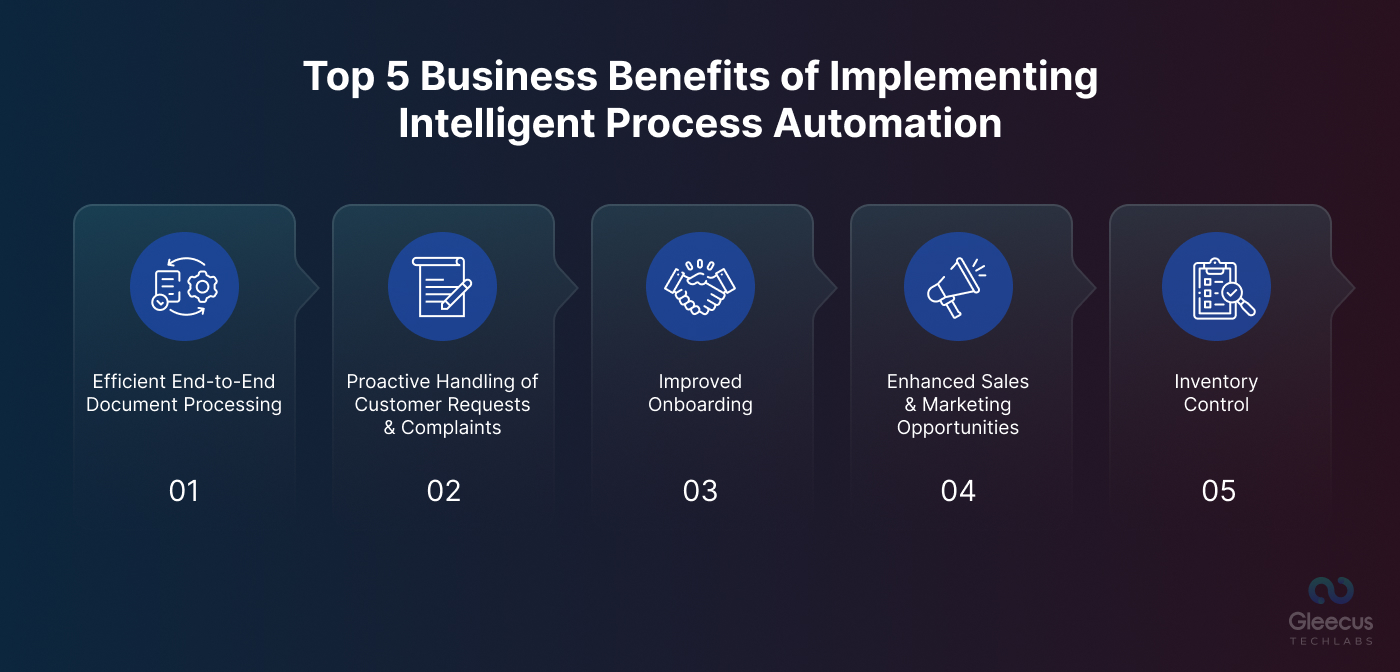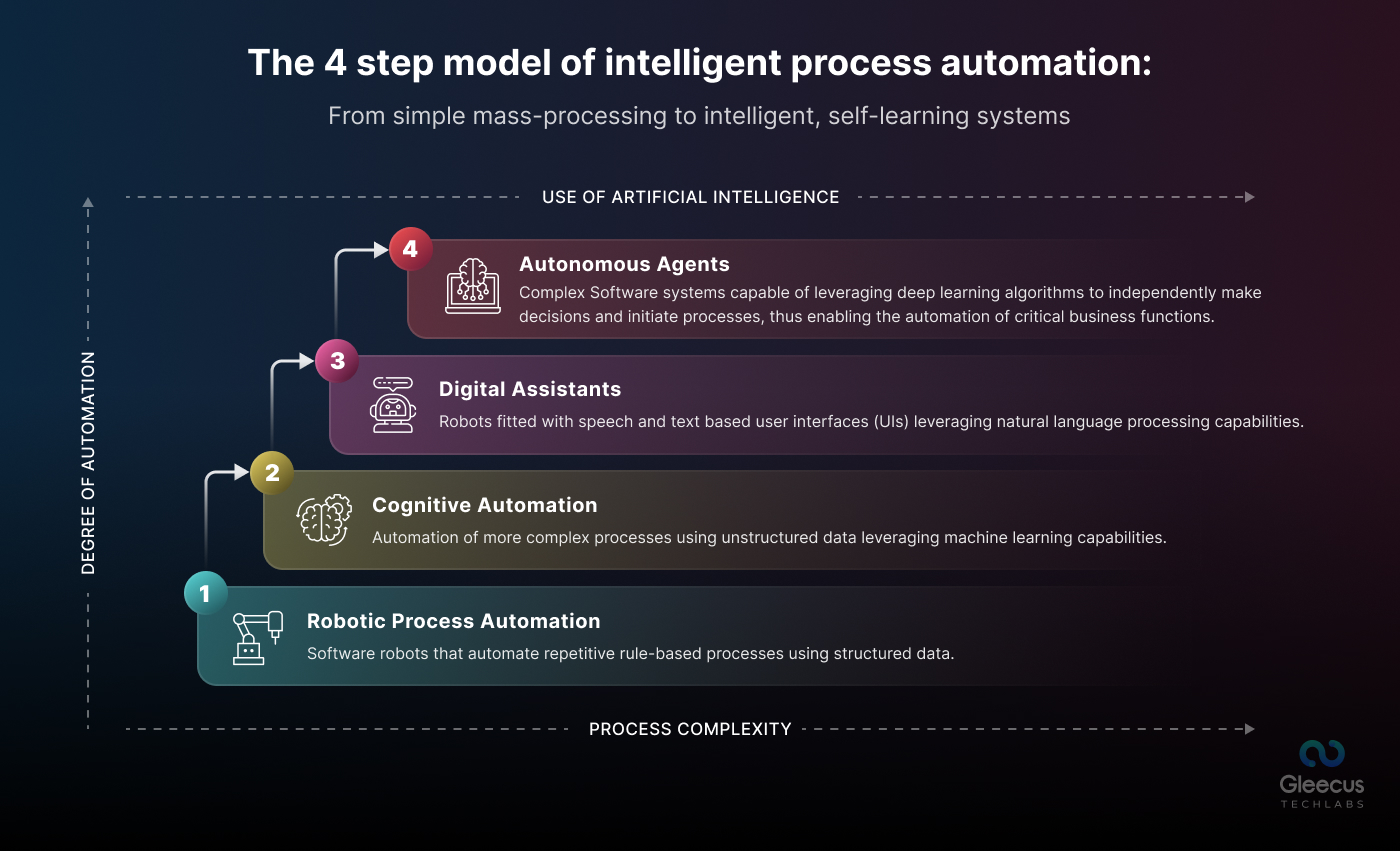Businesses often lose time and resources on repetitive tasks. While Robotic Process Automation (RPA) offers solutions to optimize these tasks, it operates on rule-based tasks. Intelligent Automation (IA) or interchangeably called, Intelligent Process Automation brings the RPA bots together and makes them execute complex tasks such as communicating with customers to answer simple queries, performing financial transactions and pulling data for analysis combining process-based automation with the cognitive power of Artificial Intelligence (AI).
The Two Components of Intelligent Automation : AI and RPA

AI
AI represents the intelligence in Intelligent Automation. It enables the RPA to handle complex and dynamic tasks like optical character recognition (OCR), speech recognition, intelligent character recognition (ICR), and sentiment analysis leveraging natural language processing. Machine learning a subfield of AI enables RPA to analyze and train on vast amount of structured and unstructured business data to improve performance in the long run.
RPA
RPA is the core automation mechanism for IA. It can automate repetitive and rule-based procedures, like data entry, invoice processing, and email handling. RPA automatically orchestrates and executes workflows across systems that don’t necessitate any changes and integrations. RPA on desktop can emulate opening files, copying data, and filling out forms. Web automation with RPA enables website navigation, data scraping, and form submission automatically. Any repetitive task that requires minimal critical thinking can be automated with RPA leaving the intelligent ones to be figured by AI.
How Intelligent Automation Creates Impact on Different Industries and Services
Retail
AI in retail is revamping the consumer experience to a great extent. Combined with RPA this space can become more attractive. RPA bots already communicate with customers integrating AI with language processing abilities can delight the customer by making it more personalized. Intelligent bots can analyze customer sentiment, provide product recommendations, and interact with them throughout the buyer’s journey even making the return process hassle-free.
Manual invoice processing is a time-consuming and error-prone task. Studies show it can cost around $10 per invoice and take up to 25 days to complete. Intelligent Automation (IA) bots can revolutionize this process. Using Optical Character Recognition (OCR) and Natural Language Processing (NLP), IA bots can:
- Automatically extract data from invoices, including amounts and purchase order references.
- Identify discrepancies between invoice amounts and purchase orders, flagging potential errors.
- Generate and distribute invoices to the appropriate employees for approval.
This automation streamlines processing, reduces costs, and minimizes errors associated with manual data entry.
ML models can analyze historical data to automatically prepare inventory allocation plans for different locations and different times of the year. Depending on purchase and returns they can automate restocking orders and save businesses from both stockout and wastage.
Healthcare
IA bots can communicate with patients and automate repetitive tasks to free up the employees from mundane customer service tasks. They can interact with the patients to understand the symptoms of a disease and automate appointment scheduling. Smart bots log every action, track and document the activity log, increase transparency, and ensure compliance. Bots can automate the sending of test results to various departments and notify them; an important transition towards smart hospitals . Training on historical data enables them to track potential fraud and prevent intended or unintended data breaches. Pre-authorization and claims processing are very tedious and labor-intensive jobs which can be automated with the help of IA.
Manufacturing
Automation is a driving technology in today’s manufacturing growth and integrating with AI leads to unprecedented agility and efficiency. Manufacturing facilities consists of a number of departments generating tons of report with often no proper means of curating and sharing them. IA can not only extract and segregate them based on its text recognition capabilities but also analyze them to derive new information.
Maintenance is a crucial activity at the manufacturing facility to prevent sudden breakdown of machines. IA can leverage predictive analytics to determine the condition of a machine and automatically create maintenance schedules.
Other significant implementation of IA lies in IA chatbot support for sales and after sales support, automatic bidding and contract placement for purchase, supplier surveys and KPI reporting, billing of materials, and automated route planning for SCM.
Finance
Staffing shortage in banking leads to straining bank’s supervisory resources one of potential contributors to the collapse of Silicon Valley Bank and Signature Bank in 2023. Intelligent Automation can provide automated support while letting employees focus on higher-value task. IA bots can resolve over 90% of customer queries offering a modern, digital-first customer experience.
IA can also free up employee time by performing a lot of time-taking, mundane but important tasks like replying to email complaints. For example, EY used NLP with ML techniques for sifting through customer complaint emails and segregating them based on nature of complaint, language and sentiment, to be shared with the appropriate department. Automated dealing of data and filling up entries can also help insurance companies to accelerate their assessment and documentation processes improving time effectiveness.
Wealth management firms go through historical data to identify trends and patterns for investment opportunity. IA can automate this process of investment with higher precision leveraging ML capabilities including risk assessment. IA also finds a significant role in fraud detection by continuously monitoring for cybersecurity breach attempts, distinguishing fake financial certificates from originals, contributing to better compliance.
Benefits of IA on Transforming Business Processes

Transforming business process management
Business process management (BPM) encompasses designing, executing, monitoring, and improving business processes aligned with organizational goals and objectives. Intelligent Automation can eliminate, simplify, or reduce steps to improve efficiency and optimize time. IA can eliminate manual intervention for verification, approval, or validation, by using AI to validate data, check compliance, or authorize transactions. Complex and cumbersome steps involved in data transformation, aggregation, or integration can be simplified by IA leveraging RPA to extract, transform, and load data from various sources and formats. IA can also automatically trigger, and coordinate processes related to order fulfillment, customer service, and compliance.
Providing data driven insights and recommendations
RPA enables the automatic collection and storage of data from various sources, such as applications, systems, sensors, or devices. IA leverages AI technique to analyze the data to provide insights and recommendations for process improvement. Machine learning models are implemented on data for descriptive, diagnostic, predictive, or prescriptive analytics and generate charts, graphs, or dashboards. Further, automatic alerts, or notifications are sent to the concerned stakeholders or systems with RPA.
Accelerating digital transformation
Intelligent Automation combines the power of AI and RPA to build new features and solutions and improve customer experience to onset digital transformation. IA fulfills customer expectations, market situations, and regulatory needs through innovative solutions. Features like voice recognition and image recognition bring about innovative and delightful experiences for the customers, while streamlining customer interaction. IA enable bots expedite delivery of information, support, and transactions based on natural human language interactions. IA also improves customer satisfaction and reduces employee workload through automated document processing, complaint redressal, detecting fraudulent activity, and automating several processes enabled with the power of AI ushering in a holistic digital transformation into the company.
Creating competitive advantage
Businesses powered by Intelligent Automation can offer better products, more personalized services, and faster response times, commanding an advantage over competitors. Unique features and solutions tailored directly to customer preferences with the help of IA helps businesses improve customer loyalty and stand out against competitors. Automating business processes improves internal efficiency and leaves time for employees to cater to more human-dependent tasks optimizing overall utilization of labor. This leads to a manual error-free, stable, and consistent operation affecting the overall business expenses.

Conclusion
Intelligent Automation is becoming a driving technology for enterprises planning digital transformation. It combines AI, ML, RPA, and NLP to introduce innovative solutions for existing business processes. IA reimagines how these technologies collectively improve processes across front, middle, and back offices to delight customers. Implementing IA requires strategic thinking and detailed roadmapping to ensure successful adoption in business operations.
